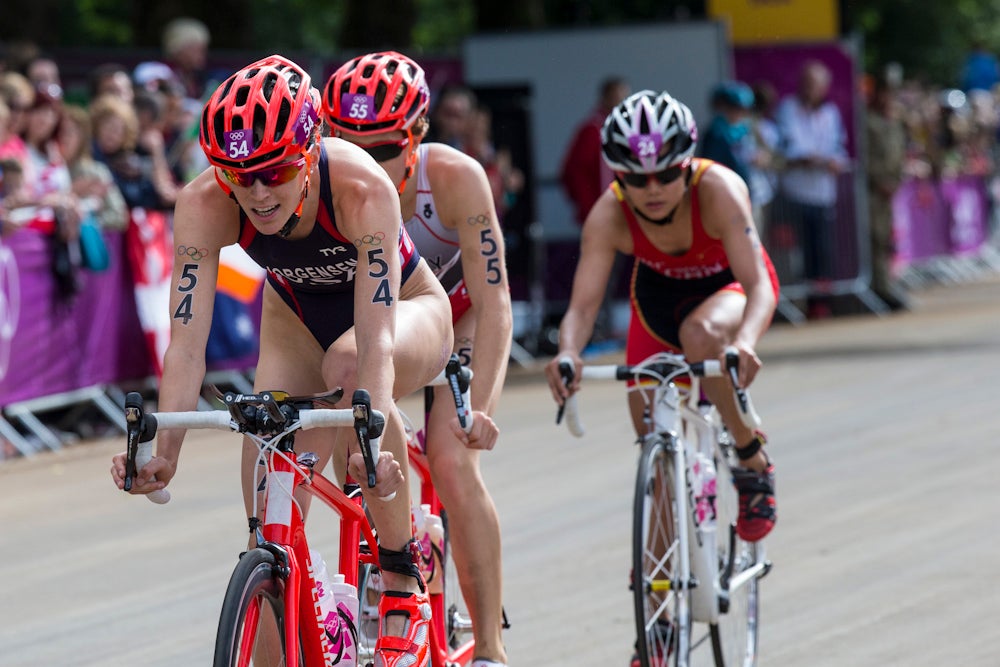Train Like Gwen: The Benefits Of A Group Ride

Photo: Paul Phillips/Competitive Image
Every triathlete can benefit from learning how to ride in a pack.
The Olympic women’s triathlon was a thriller. You couldn’t have asked for a more exciting finish than the sprint between Switzerland’s Nicola Spirig and Sweden’s Lisa Norden in London’s Hyde Park.
The excitement was marred somewhat, however, by several crashes on the bike course. Brazil’s Pamela Oliveira, Poland’s Maria Czesnik, Hungary’s Zsofia Kovacs, Italy’s Annamaria Mazzetti, and Australia’s Emma Moffatt all tipped over while rounding the same sharp corner on the tight 5.5-kilometer loop. Sadly, Moffatt, the bronze medalist in Beijing, was unable to complete the race. NBC commentator and former US Olympic triathlete (and water polo player) Julie Swail speculated that there might have been some oil residue on the road at that place, making it slick and treacherous.
Bike crashes are all too common in Olympic and World Cup triathlons. Most, however, are not caused by oily roads. Instead they are simply a natural consequence of the draft-legal format of these races, where athletes pedal in large, tightly bunched groups at high speeds.
To reduce the chances of going down in a collision with another rider many elite triathletes include group rides in their training. Among them is Gwen Jorgensen of the United States, who managed to keep the rubber side down in Hyde Park but did suffer a flat tire and consequently finished a disappointing 39th. Here is a power file from a group training ride that Jorgensen undertook on July 7. A regular part of her weekly routine at home in Milwaukee, Wisc., this 50-mile ride usually attracts 40 to 60 participants representing a range of ability levels.
Like many large group rides, the one Jorgensen participates in is both fun and competitive. Most of the cyclists who come out for it choose to ride at a moderate to moderately high intensity and there are several sprints sprinkled throughout it. Jorgensen’s coach, Cindi Bannink, encourages her to stay toward the front of the group, for the sake of getting a solid aerobic training stimulus, and to participate in the sprints. On this occasion Jorgensen’s average speed was a little over 20 mph and her normalized average power output (an average that excludes dead spots) was 195 watts. You can see the sprints on the graph where sudden spikes in power, speed, and heart rate occur. Jorgensen (who shares training files with Bannink through her account on trainingpeaks.com) hit a peak power output of 608 watts and a peak heart rate of 174 bpm in one of those sprints.
RELATED – Train Like Crowie: The Importance Of Slower Sessions
The numbers are not the main point of Jorgensen’s group rides, though. “The purpose of these group rides is twofold,” Bannink says: “to get in a solid endurance session and, more importantly, to practice pack riding skills. As cycling was Gwen’s limiter entering this sport, she has had to focus considerable time on not only gaining the strength and endurance for cycling, but also on developing the skills to ride safely and with confidence.”
This particular group ride was especially important because it was one of Jorgensen’s last opportunities to practice her pack riding skills before she left home for Europe and the London Games. Bannink placed as much weight on the psychological effects that a good experience would have on her athlete as she did on the physical effects of a good workout.
“In the draft-legal format of racing, confidence to race and perform in a pack of riders is critical,” she explained. “Every time Gwen races she learns something new and gains more knowledge of herself and the sport. The same is true of a group ride as she is able to, in a safe training environment, put into action her knowledge, test out her developing strengths, and prepare for all the various scenarios that may play out on race day. Experience and knowledge are invaluable in this sport, so we gave her every opportunity to be on the fast track in her preparation for the Games.”
Even though age-group triathletes do not compete in draft-legal races, Bannink believes that non-elites can benefit from regular group rides as well. “Developing safe bike handling skills is critical for anyone racing a bicycle, whether that is in draft-legal racing or in a time trial format,” she says. “Group rides help athletes develop skills such as riding in a straight line, cornering at speed and being comfortable riding close to others. Unfortunately, triathletes have a bad reputation in the cycling community for displaying poor bike-handling skills. Group rides and learning from experienced cyclists can be a great way to elevate one’s own cycling fitness, for comfort on the bike, skill development and accelerated fitness.”
There’s nothing any rider can do about slick spots on a road, but you can improve your ability to control your bike and your confidence in the saddle. Follow Gwen Jorgensen’s example and use group rides to improve the bike-handling reputation of triathletes!
RELATED:
– Gwen Jorgensen’s Specialized S-Works Amira SL4
– PHOTOS: U.S. Olympic Team Member Gwen Jorgensen
– Meet The U.S. Olympic Team: Gwen Jorgensen
– Gwen Jorgensen’s Cover Shoot